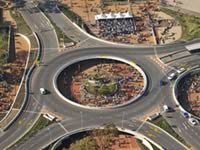 Accolades for masterpieces
Accolades for masterpieces
Most unique about the 2011 SAICE Awards is that they honour projects that push new boundaries in engineering excellence
If the country is to excel in the field of civil engineering, relevant professionals have to judge their performance by nothing but high standards. And the South African Institution of Civil Engineering (SAICE) Awards provide them with the perfect platform.
The 2011 SAICE Awards, which took place at Premier Hotel OR Tambo on 11th October 2011, included the following categories: Community-based winner, Technical Excellence commendation, Technical Excellence winner, and Civil Engineering Accolade. Individuals who had displayed outstanding excellence were also honoured through categories such as Technician/Technologist Achiever Award,Young Engineer of the Year, and Engineer of the Year.
The following were the award-winning projects:
- The Civil Engineering Accolade – Gautrain Rapid Rail Link;
- Technical Excellence joint winners – Buitengragt Structural Steel Pedestrian Bridge and Granger Bay Boulevard and Green Point Roundabout – Traffic Circle;
- Technical Excellence commendation – Warwick Triangle viaduct – outbound; and
- Community-based winner – Blackburn Pedestrian Bridge
2010 World Cup highlights
As you would have thought, there was more attention on the 2011 Awards, considering that they followed the year when the country hosted the Soccer World Cup. And some of the projects that notched awards were part of the quadrennial event’s infrastructure development, notably the Gautrain Rapid Rail Link, The Buitengragt Structural Steel Pedestrian Bridge and the Granger Bay Boulevard and Green Point Roundabout-Traffic Circle.
Feather on the cap for a pioneering project
Rapid Rail Link Project Coordinator, Olaus Van Zyl delighting in seeing the Gauteng Rapid Rail Link win the 2011 SAICE Civil Engineering Accolade says: “We are humble and thankful for the opportunity and privilege to be involved in such a fantastic once-in-a-lifetime project. Thankful for the recognition and proud of what was achieved.”
Reminiscing on the project, Van Zyl says he found the following aspects most intriguing and challenging:
- Planning and building a totally new rail system of 80km and ten stations in the most developed urban area in South Africa;
- The Greenfield aspect of the project that naturally elicited the question: “What will the reaction and usage be?”;
- The very large number of interested and affected parties, role players and third parties and all the communication issues and challenges associated with the project;
- The project integration within a very complex project;
- The roles and responsibilities of the Province(owner/client) and Bombela(Concessionaire) in this Public Private Partnership(PPP) Project with its unique Concession Agreement which was concluded after 15 months of very intense negotiations;
- Construction of the 15 kilometres of tunnels, which were largely tackled using the drill and blast technique, and the Tunnel Boring Machine(TBM);
- The implications of the project risks lying largely with the Concessionaire;
- Integrating Gautrain with the other public transport in the area eg. with Metrorail at four of our stations, with municipal bus systems and BRT at many of our stations ,and with minibus and metered taxis. Planning the ticketing so that it can be upgraded to an integrated ticket system in the foreseeable future; and
- Planning and providing the Gautrain feeder and distributor bus service to assist in providing a seamless door to door service to as many of the train passengers as possible.
Collin Matlala from Lebone Engineering, who are the Project’s Electrical and Mechanical (E&M) consultants, is equally thrilled. He mentions some of the electrical and electronic aspects in the Gauteng Project that have set new standards for South African rail systems, if not for the whole of Africa, as:
- Use of an extensive high definition CCTV network for both security and safety monitoring, most of which are infrared type;
- Gautrain is currently the only rail system in South Africa making use of Automatic Train Protection (ATP) that monitors train operation and automatically brings a train to a halt in the event of excessive speeds or passing a red signal; and
- Use of a split dual 25kV traction system using autotransformer substations as opposed to the classical 3kV DC and single 25 kV AC systems used in South Africa. This is more energy-efficient due to lower transmission losses and also has the advantage of much reduced electrical interference due to being an electrically balanced design.
The Criterion
Numerous projects in three categories – technical excellence, community-based projects and international projects – are entered for the most outstanding civil engineering achievement each year on a regional level. The winners from the regional competitions are submitted by the relevant branch chairperson to SAICE National Office.
The SAICE promotes the upholding of quality and world-class standards and encourages its members to extend their skills to compete in the global arena. And holding the SAICE Awards gives the body a perfect platform to achieve that.
In a nutshell, the objectives of the SAICE Awards are:
- to give recognition to well engineered civil projects;
- to portray the art and science of civil engineering to the general public; and
- to publicise how the profession finds answers to challenging problems.
Steeped in milestones
Since institution in 1965, the SAICE Annual Awards have grown incredibly in significance. Yearly they continue achieving the goal of giving recognition to well-engineered civil projects that portray the art and science of civil engineering to the general public and publicise how the profession finds answers to challenging problems. Most unique about the 2011 SAICE Awards is that they honour projects that push new boundaries in engineering excellence.
